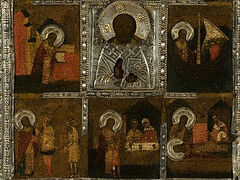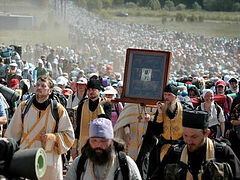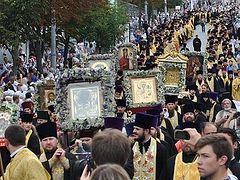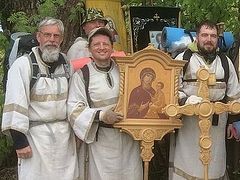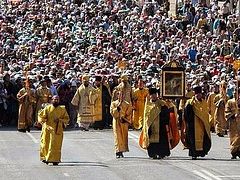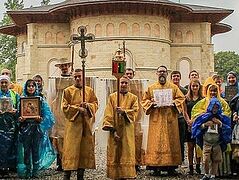June 5. It is our third day on the road. In the middle of the day, we take a break in the settlement of Gorokhovo. We rest for a while, attend a church service, and take a dip in the healing waters of the Spring of Our Lady of Kazan. This place has a beautiful, huge church, a wonder hard to find around in such a remote area. Just imagine: no presence of humans for many kilometers around or any proper roads, the locals have to use ATVs to pass through for most of the year; and there, right in the middle of deep Vyatka woods, stands a lonely Orthodox church. You keep on walking, and then, all of a sudden, you are in front of a church. It happens out of the blue and looks as if it is an air-borne mirage. There are only a couple of services held there during the year: during the Velikoretsky Procession of the cross and on the feasts of Our Lady of Kazan Mother of God. Its history is just as miraculous. There was a time when Gorokhovo, once well-populated, was famous for its fairs. A stone church was built in 1845 replacing an old wooden one that was rebuilt again in 1908 with new additions. In 1937, it was closed as a result of a conflict between its rector and the local authorities. The priest wouldn’t allow them to build a school in close proximity to his church and was later persecuted for his stance. The locals chose not to stand up for him or their church. The Bolsheviks removed the crosses from its domes, burned the icons, and built that school. In the 1960s, a farm was planned to be built in a nearby village of Marakulevschina and a new construction site needed bricks. A plan was to blow up the church. Since a total demolition could damage the school building, the wall farthest off was blown up. The wall nearest to the school was taken down by hand. A witness claimed that the walls of the bell tower and the warm-season part of the church (the oldest part of the church complex) wouldn’t go down even under a pneumatic hammer. They tried to knock over the bell tower using tractors. They wrapped steel cables around the belfry and latched them behind the machinery. The bell tower kept rocking back and forth but wouldn’t collapse. So, they dropped this idea and set up a fertilizer shed inside the church. The locals recalled that a guy who removed the cross soon died in an accident and the school building was burned down. In the 1980s, the village disappeared, together with its neighbor, Marakulevschina, whose only building left standing was the farm made of church bricks. Nowadays, the local maps don’t even mention these two settlements, instead showing the area under a vague name of “natural boundaries.” By the end of the 1990s, the church was cleared of debris and gradually restored. The white beauty of a church re-emerged again practically before our eyes, and the icons of the Savior, the Mother of God, and St. Nicholas on its brick front wall look seemingly brighter and brighter with each passing year.
 What else is Gorokhovo famous for? Of course, for its amazing kasha! It is cooked using dozens of sacks of buckwheat in several large caldrons (one of the procession-related legends dates them as far back as three hundred years old). Our remote ancestors also used to sit on the grass taking comfort in eating this hot nourishing kasha and drinking that aromatic herbal tea. Isn’t it wonderful! It is ever more wondrous that there is always enough of both kasha and tea to feed everyone!
What else is Gorokhovo famous for? Of course, for its amazing kasha! It is cooked using dozens of sacks of buckwheat in several large caldrons (one of the procession-related legends dates them as far back as three hundred years old). Our remote ancestors also used to sit on the grass taking comfort in eating this hot nourishing kasha and drinking that aromatic herbal tea. Isn’t it wonderful! It is ever more wondrous that there is always enough of both kasha and tea to feed everyone!
I come for seconds and get acquainted with our generous providers equipped with huge serving ladles. These able-bodied men are pilgrims, too, and all of them are friends. Every year, they receive a blessing to feed pilgrims with the Gorokhovskaya kasha. Roman comes from the Moscow Region; he assembles furniture and attends church of St. George the Victory Bearer in Ivanteevka. Igor is from Vyatka; he works at an electric station. Artyom is an electrical engineer who also lived in Kirov before but moved to Perm with his family. Compared to these three, Evgeniy is far from being young. He is a Cossack from Stavropol who worked as a driver all his life; he readily shares how St. Nicholas brought him to this area so far away from home:
“One day, I was driving my pickup truck in Stavropol very early, about 4 am, when, out of the corner of my eye, I noticed a priest standing at a bus stop and signaling to hitch a ride. The traffic passed him by and no one stopped to give him a lift. Well, I did stop and gave him a ride. He was the one who told me about this procession in Kirov. It sounded interesting and so I came here. Before that, all I could do at church was buy a candle; but once I went to the procession of the cross, I quit smoking, despite being a dedicated smoker for the last thirty years. I also became a church-going man. Since then, I would take my vacation time and come here every year. It’s not an easy walk for me as I am used to a warmer climate and the fresh winds of the steppes, while the marshy forests release water vapor and I have difficulty breathing.”
“Every year comes with new surprises,” Roman replies when asked if this year’s procession was more challenging than in previous years. “In 2018, there was so much rain that a bridge was swept over just after the icon went across. In 2019, we encountered a hailstorm that hammered us quite a bit. Now, this dry spell… As far as I see it, I’d like some gentle rain… It’s my third procession and I am fortunate that I have immediately found a great priest and became a part of his flock. Here he is, hearing confessions under that birch tree. Fr. Vladimir Vasilyevikh.”
That’s exactly the one I was looking for! Well, this comes as no surprise. Just another little miracle by St. Nicholas!
I’ve got the books. Besides, I heard from Fr. Vladimir about some of his spiritual children extraordinaire.
“Take Anatoly,” Batiushka points at someone. “He is from Moscow, a pilot who landed a free-falling plane last year. Its engine failed before they reached high altitude, so only his skills and God helped them survive, whereas his VIP client was able to walk away from it with a few bruises. But Tolya got hurt a bit more seriously. He was a civil aviation pilot for forty-five years and flew all kinds of higher-ups, except for maybe the President and the Prime Minister. Over there is a well-known dentist from Kirov, and the other is a doctor. My flock of sheep. As for me, it is my twenty-eighth cross procession, and I know many of those who walked before the procession became legal again. Some of them are still alive. I can’t walk, as my feet are weak, so I get to ride in a car. Something funny happened to me in Bobino. Once the tents were set up there, my guys decided to go to church. I wanted to join them but at the last moment, I realized that I can’t make it on foot and returned to my tent. The guys left but then someone unexpectedly offered me a ride to church. So, I arrived there before those guys who left on foot. They entered the church and froze. Perplexed, they asked me: ‘Batiushka, do you also walk on water?’”
The feast on the Velikaya River
June 6. It is Vigil first and a confession later in the evening spent near the monastery. A late sunset flawlessly morphs to an early sunrise. A seemingly endless stream of confessing pilgrims on the bank of a rather average-sized, by the standards of modern seasoned world travelers, yet still Velikaya (“great” in Russian.—Trans.) River. Above the water and the domes, the swifts merge with gulls, jackdaws, and all kinds of other winged creatures. Three liturgy services follow one another: from an early one at night under the stars to the one under the scorching sun.
A sermon before the Communion by Fr. Evgeniy Vinogradov, a priest from Kirov: “St. Nicholas brought us together today. What do we know about him? Almost nothing, to tell you the truth. Everything is approximate; beginning from approximately the time he was born to what year he approximately has died. The lives of two hierarchs of the Church bearing the same name were lumped together, so it was only thanks to the scholars of the twenty-first century that we could finally untangle the stories of their lives. We know the Canons of the First Ecumenical Council, yet there was no mention of the Holy Hierarch Nicholas. A modern man, with his rational mind, is quick to doubt it all. It is akin to our procession of the cross. We don’t know exactly when or where the icon had appeared. Everything looks fuzzy to us. If God isn’t with us, everything in this world seems shaky and unstable. But you and I know that the Lord is the cornerstone of it all. We all know that our Lord Jesus Christ is not the God of the dead, but the God of the living (Mark 12:27). Each of us standing here has experienced this kind of a living action by St. Nicholas in our lives. This grace-filled action that the Lord sends to us through the prayers of His saint is a fleeting but amazingly miraculous occurrence. We can answer to a man who doubts that really, we know so much about St. Nicholas. With our cross procession it’s getting even more interesting. There wasn’t anything of this kind in the old times. The icon was first carried on boats and later, in the eighteenth century, driven in a wagon. But the Lord has arranged it so wondrously when this procession survived despite the persecutions. Instead of being only an easy-going pilgrimage along with a rustic fair and street partying, it has become a full-blown procession of the cross. The procession is always about serving God in transit. It’s true we have indeed lost our holy icon. That original icon is gone. But we have found something bigger than that: the cross procession. It is an icon of another kind, an icon in the Kingdom of Heaven. So, here we are, walking in this procession to ally ourselves with the Kingdom of Heaven in such a way that the carnal becomes spiritual and the earthly is transformed into the heavenly…”
After the river waters were blessed, everyone went rushing in to take a dip. As the weariness of a long walk is forgotten and the dust washes away, we partake of tasty fast-free treats and gawk at the goodies the fair has in store for us (it is an age-old Velikoretsky tradition). But, above everything else, it is a good chance to get enough sleep! Because we will get up early again: a prayer service at 1 a.m. and the departure at 2 a.m. for our trip back. There are two more days of walking lying ahead.



